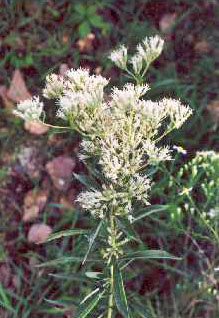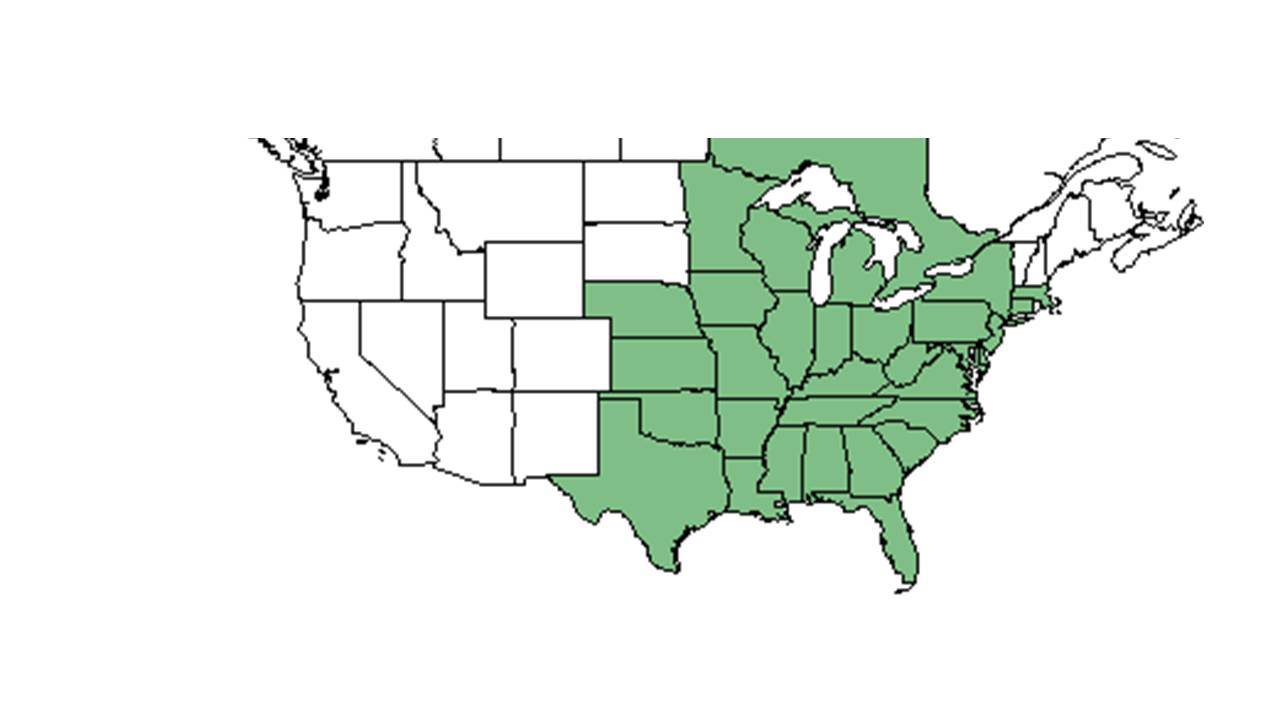Difference between revisions of "Eupatorium altissimum"
Krobertson (talk | contribs) |
Laurenloria (talk | contribs) |
||
| Line 30: | Line 30: | ||
It is found in woodlands, old fields, woodland edges, and openings over mafic rocks or calcareous rocks. <ref name="Weakley 2015"/> It is also found in roadside ditches. <ref name="FSU Herbarium"/> | It is found in woodlands, old fields, woodland edges, and openings over mafic rocks or calcareous rocks. <ref name="Weakley 2015"/> It is also found in roadside ditches. <ref name="FSU Herbarium"/> | ||
===Phenology=== <!--Timing off flowering, fruiting, seed dispersal, and environmental triggers. Cite PanFlora website if appropriate: http://www.gilnelson.com/PanFlora/ --> | ===Phenology=== <!--Timing off flowering, fruiting, seed dispersal, and environmental triggers. Cite PanFlora website if appropriate: http://www.gilnelson.com/PanFlora/ --> | ||
| − | It has been observed flowering in September. <ref name="FSU Herbarium">Florida State University Robert K. Godfrey Herbarium database. URL: [http://herbarium.bio.fsu.edu http://herbarium.bio.fsu.edu]. Last accessed: June 2014. Collectors: R. Kral. States and Counties: Florida: Liberty.</ref> Flowers from August to November according to Weakley (2015). | + | It has been observed flowering in July and September.<ref>Nelson, G. [http://www.gilnelson.com/ PanFlora]: Plant data for the eastern United States with emphasis on the Southeastern Coastal Plains, Florida, and the Florida Panhandle. www.gilnelson.com/PanFlora/ Accessed: 9 DEC 2016</ref><ref name="FSU Herbarium">Florida State University Robert K. Godfrey Herbarium database. URL: [http://herbarium.bio.fsu.edu http://herbarium.bio.fsu.edu]. Last accessed: June 2014. Collectors: R. Kral. States and Counties: Florida: Liberty.</ref> Flowers from August to November according to Weakley (2015). |
<!--===Seed dispersal===--> | <!--===Seed dispersal===--> | ||
<!--===Seed bank and germination===--> | <!--===Seed bank and germination===--> | ||
| Line 37: | Line 37: | ||
<!--===Use by animals===--> <!--Herbivory, granivory, insect hosting, etc.--> | <!--===Use by animals===--> <!--Herbivory, granivory, insect hosting, etc.--> | ||
<!--===Diseases and parasites===--> | <!--===Diseases and parasites===--> | ||
| + | |||
==Conservation and management== | ==Conservation and management== | ||
==Cultivation and restoration== | ==Cultivation and restoration== | ||
Revision as of 16:09, 9 December 2016
| Eupatorium altissimum | |
|---|---|

| |
| Photo by Jennifer Anderson, hosted by the USDA-NRCS PLANTS Database | |
| Scientific classification | |
| Kingdom: | Plantae |
| Division: | Magnoliophyta - Flowering plants |
| Class: | Magnoliopsida – Dicotyledons |
| Order: | Asterales |
| Family: | Asteraceae ⁄ Compositae |
| Genus: | Eupatorium |
| Species: | E. altissimum |
| Binomial name | |
| Eupatorium altissimum L. | |

| |
| Natural range of Eupatorium altissimum from USDA NRCS Plants Database. | |
Common name: Tall thoroughwort
Contents
Taxonomic notes
Description
A description of Eupatorium altissimum is provided in The Flora of North America.
Distribution
It is seen as far noth as CT; stretches south to Florida, and to Texas. [1] It is mostly seen in the midwest on limestone substrates, but uncommon east of the mountains. [1]
Ecology
Habitat
It is found in woodlands, old fields, woodland edges, and openings over mafic rocks or calcareous rocks. [1] It is also found in roadside ditches. [2]
Phenology
It has been observed flowering in July and September.[3][2] Flowers from August to November according to Weakley (2015).
Conservation and management
Cultivation and restoration
Photo Gallery
References and notes
- ↑ 1.0 1.1 1.2 Weakley, Alan S. Flora of the Southern and Mid-Atlantic States: Working Draft of 21 May 2015. University of North Carolina Herbarium (NCU). PDF. 1120.
- ↑ 2.0 2.1 Florida State University Robert K. Godfrey Herbarium database. URL: http://herbarium.bio.fsu.edu. Last accessed: June 2014. Collectors: R. Kral. States and Counties: Florida: Liberty.
- ↑ Nelson, G. PanFlora: Plant data for the eastern United States with emphasis on the Southeastern Coastal Plains, Florida, and the Florida Panhandle. www.gilnelson.com/PanFlora/ Accessed: 9 DEC 2016